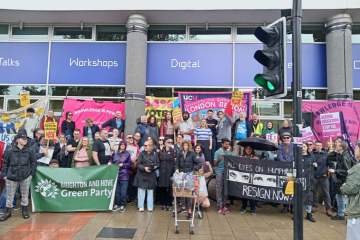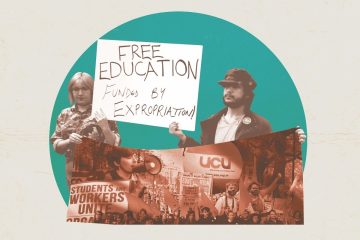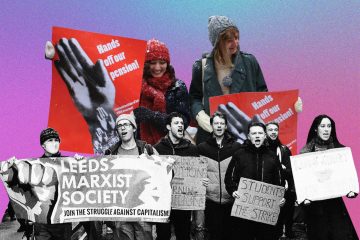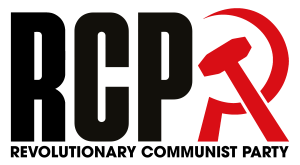The presence of students on the streets protesting for a public, free and good quality education in Chile is something that started more than a decade ago and that has developed with varying degrees of intensity. The student movement today has grown as a social movement, and not only education workers, but also miners, port workers and several trade unions of other sectors have added their voices to the protests. It is important to stress the fact concealed by the media that the student movement in Chile started from schools, and arose primarily as a response to the precarious condition of primary and secondary education throughout the country. University students joined the movement only after it had started, and have tried to direct it according to their own interests. This was the case of the student uprisings of 2002, 2006 and 2011. It is not surprising that this has taken so many years to develop as a broader social movement, for, as we know, these movements need time to come into being. Furthermore, we must add to this the social terror which was the direct result of the Dictatorship the Chilean people endured from 1973 to 1989 and which has been legally prolonged by means of the 1980 Constitution up until today.
During all these years, the Chilean education system has been regulated by the Organic Constitutional Law of Education (Ley Orgánica Constitucional de Educación, or LOCE), passed a few days before the end of the Dictatorship. This law modified the education system in different ways. Firstly, it decentralised its administration, transferring it from the state to the local councils. For this reason, the councils of wealthy neighbourhoods are able to invest more money in their schools, whereas the councils of poor neighbourhoods can scarcely invest any money in education at all. Secondly, the LOCE established a problematic relationship between public and private education by introducing a new category: the subsidised private schools. Thus there are now in Chile three different kinds of school: the municipal (with subsidy for each matriculated student), the subsidised private (funded partly by the State and partly by the students’ families), and the paid private (wholly financed by the students’ families).
With this conflicting triad the LOCE gave rise to another problem: an apparent freedom of teaching. According to the law, families are free to choose the education they want to give to their children, because the market offers them three options. However, we know that these three options do not guarantee the freedom of teaching or the right to education, because the different kinds of school neither have the same resources to provide the same ‘service’ nor are they capable of producing an equal teaching environment. The freedom of teaching in Chile is actually the freedom of the market: you choose the school that you can afford to pay for. Moreover, subsidised private schools are a breeding ground for bosses looking to make a profit, since they charge the students’ families a percentage of the tuition fees but do not vouch for the quality of the education or for a proper environment for the children’s development. This is so because teaching and administration criteria are not established by law and because there is no supervision of schools by the State.
What has been least visible in these mobilisations are the voices of municipal primary and secondary schools. Many schools have serious infrastructure problems, for example, they lack such basic things as decent bathrooms, glass in the windows, or dining halls for teachers and students. Moreover, the only meals many primary and secondary students have during the day are those provided by the National Committee for School Assistance and Scholarships (Junta Nacional de Auxilio Escolar y Becas, or JUNAEB). As a result, these schools are not able to provide the students with a safe environment for their development and to prevent them from dropping out, since in most cases they cannot provide them with adequate food, shelter, or extracurricular activities. On the other hand, teachers are badly paid and lack the non-teaching working hours they need to do their job properly. Very often they do not even have a teachers’ room where they can work together, a decent bathroom, or a space to eat or to have private meetings with students or parents. Both students and teachers therefore interact in an environment which violates their dignity, while politicians use the word ‘vocation’ to mean ‘exploitation’, which is outrageous to say the least.
Another important point to have in mind in order to understand the student movement in Chile is that the Dictatorship fragmented the public universities which had colleges throughout the country. Many of them were closed and the remaining ones were turned into private universities. As is the case with primary and secondary schools, the LOCE does not establish appropriate requirements for those who want to bring a new university to compete into the market. In addition to this, private universities do not have the same rights as the public ones, since the LOCE prohibits the organisation of universal councils of all three strata (students, academic and non-academic university workers), student unions, and trade unions.
Secondary and university students rose up against all this and demanded a different education system, which does not reproduce and aggravate the social inequalities in Chile. For this reason, with some demonstrations and occupations by students in the last decade it has been possible to bring to the foreground the need to change the LOCE and the country’s constitution. The movements which have become most well-known because of the media are the so called ‘Mochilazo’ of 2002 (which could be translated as ‘backpack hit or blow’), the ‘Pingüinazo’ of 2006 (the ‘penguins’ attack’, alluding to the school uniform), and the current mobilisations which started in 2011. I want to make absolutely clear that all these waves of mobilisation have been started and maintained by secondary school students. University students joined the movement later, took over the leadership, and obtained only benefits for themselves in negotiations with the government, thus betraying the demands of primary and secondary students. It is interesting to observe that some of the ‘pingüinos’ of 2006 were at university in 2011 and that this could have given some continuity to the original demands of the movement.
The ‘Mochilazo’ took place in 2002 under the centre-left government of Ricardo Lagos. Thousands of secondary school students broke out of school in order to march on La Alameda (the main artery of the capital, Santiago) demanding such basic things as, for example, that the bus and subway concession fares were fixed and maintained throughout the year, and not only during school months. In the ‘Pingüinazo’ of 2006, under the centre-left government of Michelle Bachelet, secondary and university students went to the streets to demonstrate throughout the country, and managed to submit the demands of the different student organisations to La Moneda (the seat of the President). In this uprising, it was remarkable the level of organisation achieved by secondary and university students, but still the one group independent from the other. On this occasion the movement’s central demand was to change the LOCE, which was replaced by the LGE. Unfortunately, the only thing that changed was the name, and not the inequality, the profit-seeking and the bad quality of Chilean education. Another important demand was the fixation of university tuition fees, which was later radicalised to the establishment of a regressive tuition fee system according to the students’ family income.
In 2011, the student movement broke out again under the right-wing government of Sebastián Piñera. Student organisation kept growing and so did civil support. This time the students’ demands radicalised again, and they went onto the streets to fight for nothing less than ‘good-quality free public education’. During this period, the CUT (Central Unitaria de Trabajadores), Chile’s largest trade union, and the students called a 48-hour general strike on August 25 and 26 2011. The workers’ demands were a new Labour Code (the existing one was bequeathed to us by Pinochet), a new pension system (current pension rates are very low), more funding for public health, and a Tax Reform. The government said that only 9% of the workers adhered to the strike, whereas the CUT maintained that it was almost 80%. In the media, the government also accused worker organisations of taking advantage of the students’ strength, but actually both secondary and university students fully supported the strike. Unfortunately, this general strike is also remembered because of the death of the secondary student Manuel Gutiérrez, who was hit by a bullet shot by the police a few steps from his home.
After the dialogue between the students and the government ended, a second general strike was called on October 18 and 19 by the university student unions, the secondary school organisations and the CUT. On those days, also the results of the plebiscite on the support or opposition to the student movement and profit in education were published: 91% of the voters supported the students’ demands and 88.1% rejected profit. Police repression increased during the strike, and the Minister of the Interior requested that the State Security Law was enforced against the demonstrators arrested for rioting. The only strategy employed by the government in order to put an end to these demonstrations has been to increase police violence, but it has not served its purpose.
In 2011, there were 108 authorised protests throughout the country, of which 38 were exclusively organised by students. It must be remembered that 2011 in Chile was also the year of demonstrations against Hidroaysén (a project to build hydroelectric power plants in Aysén Region, including 1,864 miles of high voltage electric wiring) and by other social organisations that went onto the streets and used the space that the students had recovered for the people during the last decade. Social dissatisfaction is growing in Chile and can be seen in the significant number of people that are demonstrating in order to have their demands heard.
Today, after changing the Minister of Education for the fourth time, Piñera’s government is witnessing a new outbreak of the student movement, which coincides with the primary president election and therefore with the end of his ruling period. On June 26 2013, secondary and university students, united with CUT workers, miners and port workers, called a general strike. This was widely supported by the Chilean people, and during that day 100,000 people marched on the streets of Santiago and other big cities in the country. This huge demonstration took place within the context of the students’ calling to radicalise the movement as the president election of November 2013 approaches. More than 57 schools and universities throughout the country were occupied by students. Some of them were peacefully evicted, while others were emptied by means of police violence. An exemplary case was the eviction of the students of the school Manuel de Salas, who peacefully resisted the use of force by the police (see the documentary at http://www.youtube.com/watch?feature=player_embedded&v=YcbQzpBKJBg). Likewise, on July 11 2013 the CUT called another general strike, which was sported by student unions, teacher unions, and other trade unions.
A ‘good-quality free public education’, such as the one we are now fighting for, is only possible under socialism. In the case of Chile this would entail carrying out profound social transformations. The years of student mobilisation succeed each other. We know that not everybody takes part in them in order to change the roots of the education system and of social inequality in Chile. Many of them only fight to see materialised the promise of the slogan that says that education will give a better life to you and your family. One of the pending tasks of the movement is to provide society with a general view of how the market and the neoliberal policies of the Dictatorship took over the Chilean education and, in general, over all the rights we posses as human beings. That workers of different sectors have supported the calls made by the students is an encouraging sign, and works as a social force condenser to put more pressure on both right-wing and centre-left governments. We always hear that ‘education is at the heart of society’. The right to education is at the heart of all discussions in Chile today. We cannot let that change. We have to keep it visible and urgent. We do not want to educate ourselves in order to become merely a qualified workforce. We want to educate ourselves to be free and happy.
By Camila Camacho




